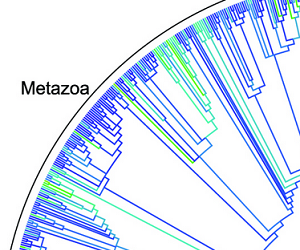The other day I received the following message:
“I'm using your R package phytools to plot a circular tree
(contMap function), but I'd like to annotate the family names
outside the tree, just like the example file attached. I have looked for it in
your blog and on internet, but I did not find anything similar with a code
available. Is this possible to do with phytools?”
In which the following is a snippet of her example:

This does not exist in R, so far as I know. However, the package plotrix, already imported by phytools, has a number of cool functions that I thought might be useful to achieve this effect.
First, here is my (beta) function:
arc.cladelabels<-function(tree=NULL,text,node,ln.offset=1.02,
lab.offset=1.06,cex=1,orientation="curved",...){
obj<-get("last_plot.phylo",envir=.PlotPhyloEnv)
if(obj$type!="fan") stop("method works only for type=\"fan\"")
h<-max(sqrt(obj$xx^2+obj$yy^2))
if(hasArg(mark.node)) mark.node<-list(...)$mark.node
else mark.node<-TRUE
if(mark.node) points(obj$xx[node],obj$yy[node],pch=21,
bg="red")
if(is.null(tree)){
tree<-list(edge=obj$edge,tip.label=1:obj$Ntip,
Nnode=obj$Nnode)
class(tree)<-"phylo"
}
d<-getDescendants(tree,node)
d<-sort(d[d<=Ntip(tree)])
deg<-atan(obj$yy[d]/obj$xx[d])*180/pi
ii<-intersect(which(obj$yy[d]>=0),which(obj$xx[d]<0))
deg[ii]<-180+deg[ii]
ii<-intersect(which(obj$yy[d]<0),which(obj$xx[d]<0))
deg[ii]<-180+deg[ii]
ii<-intersect(which(obj$yy[d]<0),which(obj$xx[d]>=0))
deg[ii]<-360+deg[ii]
draw.arc(x=0,y=0,radius=ln.offset*h,deg1=min(deg),
deg2=max(deg))
if(orientation=="curved")
arctext(text,radius=lab.offset*h,
middle=mean(range(deg*pi/180)),cex=cex)
else if(orientation=="horizontal"){
x0<-lab.offset*cos(median(deg)*pi/180)*h
y0<-lab.offset*sin(median(deg)*pi/180)*h
text(x=x0,y=y0,label=text,
adj=c(if(x0>=0) 0 else 1,if(y0>=0) 0 else 1),
offset=0)
}
}
library(phytools)
library(plotrix)
tree
##
## Phylogenetic tree with 100 tips and 99 internal nodes.
##
## Tip labels:
## t1, t7, t25, t26, t2, t3, ...
##
## Rooted; includes branch lengths.
nodes<-c(104,118,122,137,149,175,189,190)
labels<-paste("Clade",LETTERS[1:length(nodes)])
plotTree(tree,type="fan",lwd=1,ftype="off",xlim=c(-1.1,1.1))
for(i in 1:length(nodes))
arc.cladelabels(text=labels[i],node=nodes[i])
Maybe we notice that for two of the clades there is not really enough space to plot their labels circularly, and would rather plot them horizontally. We can do this too:
plotTree(tree,type="fan",lwd=1,ftype="off",xlim=c(-1.1,1.1))
for(i in 1:length(nodes))
arc.cladelabels(text=labels[i],node=nodes[i],
orientation=if(labels[i]%in%c("Clade B","Clade G"))
"horizontal" else "curved")
If we want to include tip labels in the plot we will need to adjust
the two arguments ln.offset and lab.offset,
which are specified as a multiplier of total tree depth. You may also notice
that the clades to be labeled have their MRCA noted with a red dot. We can
turn this off easily.
plotTree(tree,type="fan",lwd=1,ftype="i",fsize=0.7,xlim=c(-1.2,1.2))
for(i in 1:length(nodes))
arc.cladelabels(text=labels[i],node=nodes[i],ln.offset=1.1,
lab.offset=1.15,mark.node=FALSE)
Finally, it is straightforward to use this with other plotting methods,
such as plot.simmap or plot.contMap. For instance:
x
## t1 t7 t25 t26 t2
## 0.185429207 0.094608262 0.760719557 0.963119247 -0.613742776
## t3 t13 t30 t31 t35
## 0.248102131 -0.118475199 0.694191486 0.071582483 0.050032594
## t50 t51 t70 t86 t87
## 0.032262629 -0.001892491 -0.229326634 0.283981779 0.164694487
## t32 t71 t72 t55 t76
## -0.861695430 -0.352169565 -0.797383594 -0.147875574 0.059193790
## t77 t66 t67 t34 t22
## -0.236570859 0.523480198 -0.055877020 -0.012512494 0.128464862
## t4 t64 t65 t48 t49
## 0.213153746 -0.928063215 -0.648886144 -0.684025531 0.006881137
## t15 t16 t91 t92 t21
## 1.523355788 1.218056983 2.038305894 2.019228156 -0.851746986
## t38 t39 t99 t100 t95
## -0.119677916 -0.090495321 0.444701776 0.445875273 0.189022674
## t96 t73 t82 t83 t20
## 0.067742383 -0.423314363 -0.371488270 -0.406287550 -0.512160615
## t28 t29 t24 t97 t98
## 0.247582627 -0.879421691 0.221554029 -0.227690642 -0.242492947
## t14 t17 t81 t89 t90
## -0.627299910 0.187249019 -1.788281688 -1.673693103 -1.608081213
## t88 t58 t59 t27 t56
## -1.736842698 -0.924691207 -1.313277929 -0.878893215 0.317057217
## t57 t62 t63 t52 t11
## 0.146722922 -1.035700313 -1.042831693 -0.853733850 -0.427358894
## t9 t33 t84 t85 t78
## -1.257660829 -0.990611837 -1.239630360 -1.095542278 -1.063870076
## t93 t94 t60 t61 t8
## -0.144898325 -0.436375725 2.675756270 2.523984420 2.657743208
## t68 t69 t53 t54 t40
## 1.632048013 1.937727602 2.119883643 2.527910126 2.344777813
## t41 t74 t75 t79 t80
## 1.762067736 2.630088860 2.361542350 2.651599024 2.761170468
## t6 t5 t46 t47 t18
## 1.519560349 2.667583940 0.945310915 1.491948899 1.299554468
## t19 t23 t44 t45 t36
## 0.902194960 0.497576835 0.834872192 1.858746870 1.234396753
## t37 t12 t10 t42 t43
## 1.425951772 1.439553510 1.922945651 2.420284774 2.341460432
obj<-contMap(tree,x,plot=FALSE)
obj<-setMap(obj,invert=TRUE) ## invert color map
plot(obj,ftype="off",type="fan",outline=FALSE,legend=0.4,
fsize=c(0,0.8))
for(i in 1:length(nodes))
arc.cladelabels(text=labels[i],node=nodes[i],
orientation=if(labels[i]%in%c("Clade B","Clade G"))
"horizontal" else "curved",mark.node=FALSE)
(Non-aliased version here.)
Some bugs to iron out, no doubt - but not bad!
This comment has been removed by the author.
ReplyDeleteLiam, this clade labels are fantastic! But, I wonder if there is a possible way to determine clades by the tips (instead of by the nodes), since some clades could have just one branch.
ReplyDeleteAll the best,
- Carlos Biagolini-Jr.
Hi Carlos. I just posted a solution here. Let me know if this helps. - Liam
DeleteThank you Liam, it opens new possibilities to display phylogenetic data!
ReplyDelete- Carlos
It would be good to have the lab.offset in cladelabels too
ReplyDelete